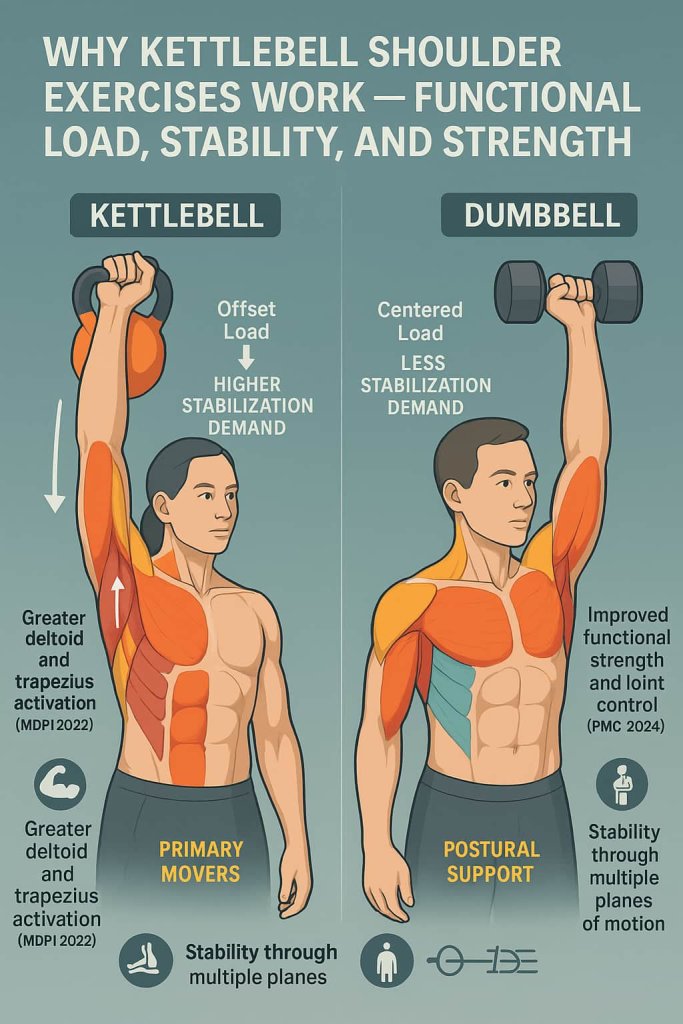Kettlebell shoulder exercises are one of the most effective ways to build real-world strength, stability, and power.
The unique offset load of a kettlebell challenges your shoulder muscles and stabilizers in ways traditional dumbbells can’t. Understanding these exercises is essential because the shoulders are both highly mobile and vulnerable — demanding strength and control to stay healthy.

In this guide, you’ll learn 15 of the best kettlebell shoulder exercises, how to perform them safely, and how to program them for balanced upper-body development. You’ll also discover why research increasingly supports kettlebell training for joint stability, posture, and functional power.
Why Kettlebell Shoulder Exercises Work
Functional Load and Stabilization
Unlike dumbbells, a kettlebell’s center of gravity sits below its handle. This offset load forces your rotator cuff, trapezius, and deltoids to stabilize through multiple planes of motion, enhancing shoulder control and resilience.

Research Insight
A 2022 MDPI study comparing kettlebells and dumbbells found greater activation of the anterior and posterior deltoids, lower trapezius, and serratus anterior during the kettlebell overhead press.
Another 2024 PMC review concluded that kettlebell training improves overall strength, power, and functional capacity across sports and rehabilitation contexts.
Benefits at a Glance
- Builds deltoid and rotator cuff strength
- Improves shoulder mobility and posture
- Enhances coordination and joint stability
- Reduces risk of injury through balanced activation
Programming Guidelines
| Goal | Sets × Reps | Rest | Notes |
|---|---|---|---|
| Stability & Control | 2–3 × 10–12 | 60–90 sec | Slow tempo, light kettlebell |
| Strength | 3–4 × 6–8 | 90–120 sec | Moderate to heavy weight |
| Power | 3 × 3–5 | 2–3 min | Explosive but controlled |
| Endurance | 2–3 × 12–15 | 45–60 sec | Focus on consistent rhythm |
15 Best Kettlebell Shoulder Exercises
These kettlebell shoulder exercises target strength, stability, and power through controlled and functional movement patterns.
Each one builds balanced shoulder development while reinforcing posture, coordination, and joint integrity.
1. Kettlebell Overhead Press
Why it works:
This classic shoulder builder develops pure pressing strength while enhancing scapular and rotator cuff stability. Because the kettlebell’s weight sits behind the wrist, it demands more control than a dumbbell press, recruiting stabilizers like the lower trapezius and serratus anterior.
Muscles worked:
Anterior and lateral deltoids, upper trapezius, triceps brachii, rotator cuff (supraspinatus, infraspinatus).
How to do it:
- Stand tall with feet hip-width apart and core braced.
- Clean the kettlebell into rack position, elbow tucked close to your ribs.
- Press the kettlebell overhead in a straight line until your arm is fully extended.
- Lower slowly under control and repeat.
Trainer Tip:
Avoid arching your lower back. Think “ribs down, glutes tight, abs engaged.” Keep your bicep close to your ear at the top position.
2. Kettlebell Push Press
Why it works:
Combines leg drive with shoulder pressing for more power output and athletic coordination. This move improves overhead strength and kinetic chain efficiency from legs to arms.
Muscles worked:
Deltoids, triceps, quadriceps, glutes, core stabilizers.
How to do it:
- Start in the rack position.
- Slightly bend your knees and hips.
- Explosively extend your legs while pressing the kettlebell overhead.
- Lock out at the top, then lower under control.
Trainer Tip:
Time your leg drive and press together. The legs initiate force — the shoulders finish it.
3. Kettlebell Bottoms-Up Press
Why it works:
An advanced stability drill that strengthens the shoulder’s deep stabilizers. Balancing the kettlebell upside down challenges your grip, forearm, and rotator cuff.
Muscles worked:
Deltoids, rotator cuff, forearms, wrist flexors and extensors.
How to do it:
- Hold the kettlebell inverted (bottom up) at shoulder level.
- Engage your core and press straight overhead.
- Lower with control without letting the bell tilt.
Trainer Tip:
Begin with a light kettlebell (4–8 kg). Focus on control, not load — shaking is normal at first.
4. Kettlebell Halo
Why it works:
Improves shoulder mobility, scapular movement, and postural control. It also strengthens the smaller stabilizers that prevent impingement.
Muscles worked:
Rotator cuff, trapezius, rhomboids, posterior deltoid.
How to do it:
- Hold a kettlebell by the horns at chest height.
- Circle it slowly around your head, keeping elbows close.
- Return to start and reverse direction.
Trainer Tip:
Move smoothly — no jerks. Keep your head still and chest tall throughout the motion.
5. Kettlebell Clean to Press
Why it works:
Combines lower-body power and upper-body strength in one seamless motion. Builds full-body coordination and shoulder endurance.
Muscles worked:
Deltoids, traps, triceps, glutes, hamstrings, core.
How to do it:
- Clean the kettlebell from the floor to the rack position using a hip hinge.
- From the rack, press overhead.
- Lower back to the floor or rack and repeat.
Trainer Tip:
Master the clean first — avoid letting the kettlebell slap your wrist. Keep your elbow close to your torso.
6. Kettlebell Snatch
Why it works:
A total-body power exercise that demands shoulder control and timing. Great for athletic performance and metabolic conditioning.
Muscles worked:
Deltoids, lats, traps, glutes, hamstrings, core.
How to do it:
- Swing the kettlebell between your legs.
- Drive hips forward explosively, pulling the kettlebell upward close to your body.
- “Punch” your hand through at the top for a smooth lockout.
- Lower safely and repeat.
Trainer Tip:
Keep the bell close to your body — not an arc. Use hips, not arms, for power.
7. Kettlebell Upright Row
Why it works:
Targets the upper traps and lateral deltoids to enhance shoulder width and posture.
Muscles worked:
Lateral deltoid, upper trapezius, rhomboids, biceps.
How to do it:
- Hold the kettlebell with an overhand grip in front of thighs.
- Pull upward to chest height, elbows leading.
- Pause briefly, then lower under control.
Trainer Tip:
Don’t pull too high — stop around mid-chest to protect shoulder joints.
8. Kettlebell Front Rack Carry
Why it works:
Strengthens isometric shoulder and core endurance while reinforcing upright posture.
Muscles worked:
Deltoids, serratus anterior, obliques, erector spinae.
How to do it:
- Clean the kettlebell to rack position.
- Keep elbow close and wrist straight.
- Walk 20–30 meters while maintaining posture.
Trainer Tip:
Keep ribs down and avoid leaning backward. The bell should rest lightly on your forearm.
9. Kettlebell Rack Hold with Presses
Why it works:
Combines static and dynamic shoulder strength for superior control. Builds endurance in the delts and triceps.
Muscles worked:
Deltoids, triceps, rotator cuff, core stabilizers.
How to do it:
- Hold the kettlebell in rack position for 15–30 seconds.
- Perform 4–6 controlled overhead presses.
- Lower and repeat on the other side.
Trainer Tip:
Focus on tension — maintain a tight core even during the hold.
10. Kettlebell Reverse Fly
Why it works:
Develops posterior deltoids and scapular retractors, improving shoulder balance and reducing forward posture.
Muscles worked:
Posterior deltoid, rhomboids, middle trapezius.
How to do it:
- Hinge forward with a flat back.
- Hold kettlebell in one hand and lift it outward to shoulder height.
- Lower slowly under control.
Trainer Tip:
Lead with the elbow, not the hand. Keep shoulders relaxed away from ears.
11. Kettlebell Bottoms-Up Carry
Why it works:
Engages the shoulder, core, and grip under continuous stabilization. Excellent for improving coordination and injury resilience.
Muscles worked:
Deltoids, rotator cuff, forearms, core.
How to do it:
- Hold kettlebell upside down (bottom up) with elbow bent 90°.
- Walk slowly 20–30 meters maintaining balance.
- Switch arms and repeat.
Trainer Tip:
Keep wrist vertical and eyes forward. Any tilt means your shoulder has lost engagement.
12. Kettlebell Overhead Carry
Why it works:
Trains overhead stability, scapular control, and posture endurance — key for athletic and everyday tasks.
Muscles worked:
Deltoids, upper traps, serratus anterior, obliques, glutes.
How to do it:
- Press the kettlebell overhead with a locked arm.
- Maintain tight core and upright torso.
- Walk 15–30 meters per arm.
Trainer Tip:
If the bell drifts or shakes, lower weight. Quality beats distance.
13. Kettlebell Windmill
Why it works:
Integrates shoulder stability with hip mobility and core strength. Strengthens obliques and stabilizers through rotation and load control.
Muscles worked:
Deltoids, obliques, glute medius, hamstrings, rotator cuff.
How to do it:
- Press kettlebell overhead.
- Turn feet slightly away from the kettlebell side.
- Hinge at hips, reaching opposite hand toward floor while keeping eyes on the bell.
- Return to standing.
Trainer Tip:
Move slowly — hinge at hips, not waist. Prioritize form over range.
14. Kettlebell Turkish Get-Up
Why it works:
One of the most complete shoulder stability exercises. It trains the rotator cuff, deltoids, and core through multiple planes of motion.
Muscles worked:
Deltoids, rotator cuff, core, glutes, hip stabilizers.
How to do it:
- Lie flat with kettlebell pressed overhead.
- Use opposite hand and leg to rise step-by-step (elbow → hand → hips → knee → stand).
- Reverse sequence to return down.
Trainer Tip:
Stay slow and deliberate — the shoulder should remain locked and vertical throughout.
15. Kettlebell Press Walk
Why it works:
Teaches the shoulder to maintain strength under dynamic movement, integrating balance and coordination.
Muscles worked:
Deltoids, triceps, core, glutes.
How to do it:
- Press the kettlebell overhead.
- Take small, controlled steps for 10–20 meters.
- Lower carefully, switch sides.
Trainer Tip:
Keep your spine neutral and avoid side bending. Move at a steady pace — stability first.
Safety and Precautions
- Warm up with light mobility drills before lifting.
- Start light and focus on control before load.
- Keep your wrist straight and shoulder packed (avoid shrugging).
- Stop immediately if you feel pain or instability.
- Those with shoulder injuries should consult a physiotherapist before overhead work.
Common Mistakes
- Letting kettlebell drift behind shoulder alignment.
- Overusing momentum instead of controlled strength.
- Ignoring posture and rib alignment during pressing.
- Skipping rear-delt and stabilizer work.
FAQs
1. Can beginners do kettlebell shoulder exercises?
Yes. Start with light presses, halos, and carries to build stability before heavy or ballistic lifts.
2. How often should I train shoulders with kettlebells?
Two sessions per week is ideal for recovery and progress.
3. Which kettlebell weight should I start with?
Men: 8–12 kg | Women: 4–8 kg, depending on control and form.
4. Are kettlebell shoulder exercises better than dumbbells?
For stability and coordination — yes. For pure hypertrophy, dumbbells still have a role.
5. Can I do these if I have shoulder pain?
Consult a healthcare provider first. Focus on mobility and stability drills before loading overhead.
6. How do I progress safely?
Add weight gradually, increase time under tension, and introduce advanced variations like bottoms-up or windmills.
Conclusion
Kettlebell shoulder training builds strength, mobility, and control — the three pillars of a resilient upper body.
By integrating these 15 exercises into your routine, you’ll enhance your posture, boost athletic performance, and protect your shoulders for the long term.
Start today — pick three movements (a press, a carry, and a stability drill) and master your form before adding load.
References
- Kettlebell Training in Clinical Practice — Scoping Review (2019)
BMC Sports Science, Medicine and Rehabilitation
https://bmcsportsscimedrehabil.biomedcentral.com/articles/10.1186/s13102-019-0130-z - Effect of Implement Type (Kettlebell vs. Dumbbell) on Overhead Press Muscle Activation (2022)
Sensors (MDPI)
https://www.mdpi.com/1424-8220/22/24/9762 - Enhancing Athletic Performance: A Comprehensive Review on Kettlebell Training (2024)
PMC (open-access review)
https://pmc.ncbi.nlm.nih.gov/articles/PMC10910645/ - Surface Electromyographic Analysis of Differential Effects in Kettlebell Carries (2017)
PMC (open-access study)
https://pmc.ncbi.nlm.nih.gov/articles/PMC6003386/ - Stability of Resistance Training Implement Alters EMG Activity During the Overhead Press (2020)
International Journal of Exercise Science
https://digitalcommons.wku.edu/ijes/vol11/iss1/6
